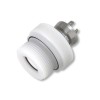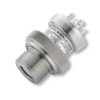Plastic externally fitted hydrostatic level sensors with ceramic diaphragms offer a reliable and cost-effective solution for measuring liquid levels in chemical storage tanks. Their non-metallic construction ensures compatibility with a wide range of aggressive media, while the flush diaphragm design facilitates easy cleaning and maintenance. These sensors are typically used in industries such as chemical processing, water treatment, and pharmaceuticals, where accurate and dependable level measurement is essential.
 LMK351 High Overpressure Flush Level Transmitter - Flush capacitive ceramic pressure sensor for measuring corrosive and viscous liquid level from levels 0.4 metres of water up to 200 mH2O.
LMK351 High Overpressure Flush Level Transmitter - Flush capacitive ceramic pressure sensor for measuring corrosive and viscous liquid level from levels 0.4 metres of water up to 200 mH2O.  LMK331 Screw-In Ceramic Level Transmitter - Level pressure sensor with semi-flush ceramic diaphragm and stainless steel or PVDF wetted parts in ranges from 0-4 to 600mH2O gauge.
LMK331 Screw-In Ceramic Level Transmitter - Level pressure sensor with semi-flush ceramic diaphragm and stainless steel or PVDF wetted parts in ranges from 0-4 to 600mH2O gauge.
- Viscous machine tool coolant level measurement with flush diaphragm sensor
- Seawater depth sensor with I2C output for aquaculture underwater camera integration
 Chemical Resistant Hydrostatic Liquid Level & Pressure Sensors - Find durable hydrostatic liquid level and pressure sensors designed for harsh chemical environments. Ideal for storage tanks and process applications requiring high corrosion resistance.
Chemical Resistant Hydrostatic Liquid Level & Pressure Sensors - Find durable hydrostatic liquid level and pressure sensors designed for harsh chemical environments. Ideal for storage tanks and process applications requiring high corrosion resistance.
Find out more about Plastic Externally Fitted Hydrostatic Liquid Level Sensors to determine which product options and capabilities will best meet your application requirements.
Plastic externally fitted hydrostatic level sensors with ceramic diaphragms are specifically designed for level measurement in chemical storage tanks. These sensors are constructed with a durable plastic housing and a chemically resistant ceramic diaphragm, making them suitable for use with a wide variety of aggressive liquids. The external fitting design allows for non-invasive installation without requiring any modifications to the tank itself. This is particularly advantageous in applications where internal access is restricted or where the process cannot be interrupted.
One of the key features of these sensors is their flush diaphragm. This design eliminates any crevices or cavities where process media could accumulate, thereby preventing clogging and ensuring accurate measurements. The smooth surface of the diaphragm also facilitates easy cleaning and maintenance, reducing downtime and operational costs.
Another important aspect of these sensors is the use of a plastic threaded port. This ensures that no metal components are exposed to the process media, eliminating the risk of corrosion and ensuring the longevity of the sensor. The threaded connection provides a secure and leak-proof seal, preventing any spills or leaks that could pose safety hazards or environmental concerns.
Applications
Plastic externally fitted hydrostatic level sensors with ceramic diaphragms excel in environments where corrosive chemicals are present. Their unique construction materials and design features ensure compatibility and longevity even with the harshest media. Here’s a closer look at how these sensors address the challenges of handling acids and alkalines:
- Acid Storage and Processing: Industries often store and process highly corrosive acids such as sulfuric acid, hydrochloric acid, and nitric acid. These sensors, with their chemically inert plastic housing and ceramic diaphragm, can reliably monitor acid levels in storage tanks, process vessels, and transportation containers. The flush diaphragm design prevents acid build-up, ensuring accurate readings and minimizing maintenance requirements.
- Alkaline Solutions Management: Similarly, the sensors are well-suited for managing alkaline solutions like sodium hydroxide (caustic soda) and potassium hydroxide. These chemicals are widely used in industries ranging from pulp and paper production to textile manufacturing. The sensors’ resistance to corrosion ensures accurate level measurement in storage tanks, mixing tanks, and pipelines carrying alkaline solutions.
- Neutralization Processes: In wastewater treatment and chemical processing, acids and alkalines are often neutralized to control pH levels. These sensors can accurately monitor the levels of both acidic and alkaline solutions in neutralization tanks, helping to maintain the desired pH balance and prevent overshooting or undershooting.
- Chemical Manufacturing: The production of various chemicals often involves the use of strong acids and alkalines as reactants or catalysts. These sensors can be employed to monitor the levels of these chemicals in reactors, distillation columns, and storage vessels. The non-invasive external fitting allows for easy installation without compromising the integrity of the process equipment.
By utilizing these specialized sensors, industries handling corrosive acids and alkalines can ensure safe and efficient operations while minimizing the risk of equipment damage and environmental contamination.
When selecting a plastic externally fitted hydrostatic level sensor with a ceramic diaphragm, it is important to consider factors such as the specific application requirements, the chemical compatibility of the materials, the pressure and temperature range, and the desired accuracy and output signal. By carefully evaluating these factors, engineers can choose the most suitable sensor for their specific needs.
